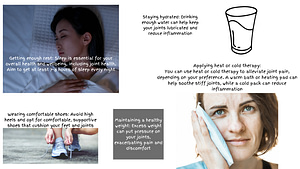As a women’s health advocate, I want to help you understand and manage menopause joint pain – a challenge I know many of us face during perimenopause and beyond. Let me share what I’ve learned about this common but manageable condition. During my research, I’ve found that joint pain often begins in perimenopause and can persist for a year or more after your last period. Think of your hormones like conductors in an orchestra – when one conductor (estrogen) steps back, it affects the entire performance of your body.
Here’s what’s actually happening in your body:
– Estrogen levels naturally decline
– This decline disrupts your body’s natural balance
– Lower estrogen affects bone health
– Inflammation in joints increases
– Pain and discomfort become more common
I want to dispel some common myths about menopause joint pain:
1. It’s not an inevitable part of aging
2. You don’t have to “just live with it”
3. There are effective ways to manage and reduce the pain The good news is that you can take control of your joint health during menopause. Scientific research supports various management strategies that I’ll share with you. By understanding the connection between hormones and joint pain, you’re already taking the first step toward finding relief.
Stay tuned as I share powerful techniques to help you reclaim comfort and joy in your daily activities. Remember, you’re not alone in this journey; there is hope for relief.
1. Taking Care of Your Body: The Basis for Meno-Joint Health
I recommend taking care of your body from the inside out to promote joint health. Your diet is crucial to your overall health story and goes beyond mere nutrients. Based on my research, focusing on a diet rich in antioxidants, calcium, and omega-3 fatty acids offers your best defense against menopausal joint pain.
I strongly suggest incorporating dairy, leafy greens, walnuts, flaxseeds, and fatty seafood into your daily meals. In my experience, calcium and vitamin D deserve special attention for maintaining bone health. The Mediterranean diet stands out for its joint-friendly qualities, featuring an abundance of fresh fruit, healthy grains, and lean proteins. These nutrient-dense powerhouses actively fight inflammation, strengthen your bones, and create a solid foundation for managing menopausal joint discomfort.
2. Establishing a Solid Exercise Routine
I understand that when your joints hurt, exercise might be the last thing on your mind, but I’ve seen how the right kind of movement can work wonders. Regular exercise proves essential for joint health. Beyond helping with weight management, I’ve found that low-impact exercise significantly improves joint function. I recommend starting with brisk walking or cycling – these aerobic exercises boost blood flow to your joints, enhancing mobility and overall wellness. When I work with clients, I emphasize how strength training helps maintain muscle mass, providing crucial support for your joints.
I’ve also discovered that flexibility exercises like swimming or yoga excellently promote joint range of motion. In my professional opinion, creating a comprehensive routine that addresses multiple aspects of your joint health, elevates your mood, and provides a holistic approach to comfort matters just as much as the exercise itself. I encourage you to make it enjoyable and sustainable for your lifestyle.
3. My Mind-Body Journey: Finding Joint Pain Relief Through Holistic Healing
I’ve learned that my mind and body are deeply connected, especially during menopause. When I manage my stress levels, I notice my joint pain improves. Research shows that chronic stress can increase inflammation, making our joint pain worse. Here’s what I’ve found helpful:
• Mindfulness meditation – I take a few minutes each day to focus on the present moment • Deep breathing exercises – This helps activate my body’s natural relaxation response • Progressive muscle relaxation – I use this technique to release physical tension
By creating these peaceful moments in my day, I’ve noticed my body becomes more resilient to discomfort. It’s like giving myself a daily dose of natural pain relief.
4. My Guide to Menopause Joint Pain Supplements
In my journey to manage joint pain, I’ve explored various supplements that can help. Here are the key ones I’ve learned about:
• Glucosamine and Chondroitin: Think of these as your joint’s maintenance crew. While they’re popular choices, their effectiveness can vary from person to person.
• Omega-3 Fatty Acids: I’ve found fish oil supplements particularly helpful as natural anti-inflammatories. They’re like sending a peaceful message to my inflammatory response.
• Joint Genesis: This is a newer option that some women find helpful, though results can vary significantly.
Remember, what works for me might not work for you. I always recommend checking with your healthcare provider before starting any new supplement regimen. They can help create a personalized plan that considers your specific needs and medical history.
5. Creating a Joint Pain-Friendly Environment
I want to share how small changes to your surroundings can make a significant difference in managing joint discomfort. In my experience working with menopausal women, I’ve found that ergonomics plays a crucial role in improving daily life by preventing postural strain and enhancing overall well-being. You can learn more about this in the comprehensive guide to ergonomics in daily life. I recommend making deliberate adjustments to your daily routine and environment to reduce joint strain. While I’ve seen great results from various methods like exercise, diet, and medical treatments for managing menopause joint pain, I find that optimizing your physical environment is often overlooked, as noted in current menopause research.
6. Seek Expert Advice: Customised Solutions for Your Meno-Joint Experience
I want to emphasize that your body and menopausal journey are uniquely yours, as highlighted in Dr Brighten’s research on menopausal joint pain. I strongly encourage you to seek professional advice if your joint pain persists or worsens. In my practice, I’ve seen how menopause specialists and other medical professionals can provide you with personalized treatment plans that give you the individual attention you need to navigate this stage with grace and comfort.
7. Community of Comfort: Real Women, Real Solutions
I want you to know that you’re not alone on this path. From my experience and research, talking with other women who are experiencing menopausal joint pain can be incredibly therapeutic and enlightening. As noted in the WHO’s guidelines on menopause, building a support network is crucial during this transition. I’ve found great comfort in connecting with others through online forums, local support groups, and community meetups where we share strategies and success stories.
Joint Pain During Menopause: A Chapter, Not the Entire Tale
Let me be clear: menopause-related joint pain is just one chapter in your life story. It doesn’t define you. According to Medical News Today’s comprehensive guide on menopause and joint pain, this phase is manageable with the right approach. I’ve learned that combining medical knowledge with practical strategies can make a real difference in how we navigate this transition.
During my research into joint pain solutions, I came across Joint Genesis. While exploring user experiences, I found mixed feedback. Some women report significant improvement in their joint comfort, while others didn’t see the results they hoped for, as documented in customer reviews. What’s most important is finding what works best for your individual needs.
Remember, this is your unique journey of transformation. With the right tools, support, and mindset, you can navigate through menopause and emerge feeling stronger and more empowered. I’ve seen countless women turn this challenge into an opportunity for growth and renewed vitality. You’ve got this, and we’re here to support you every step of the way!
The Pause Life Retreat: A Sanctuary for Menopausal Wellness
I want to tell you about a special place where we understand and support your menopausal journey, especially when it comes to joint pain. At The Pause Life Retreat, we’ve created a sanctuary that empowers women like you who are navigating menopause. Through our expert-led workshops, personalized wellness plans, and supportive community, we help transform your menopausal experience into a period of growth and rejuvenation.
We take a comprehensive approach to managing your joint pain during menopause. Our program includes:
- Carefully selected physical activities that support joint health
- Expert nutritional guidance focusing on anti-inflammatory foods
- Proven relaxation techniques for stress reduction
- Mindfulness meditation practices
- Progressive muscle relaxation exercises
Each element of our program helps you achieve harmony between your mind and body while effectively managing joint discomfort. You can learn more about our specialized approach to menopause joint pain through our comprehensive treatment guide.
One of the most valuable aspects of our retreat is the sense of community we foster. Here, you’ll connect with other women who understand exactly what you’re experiencing. Watch how our community supports each other in this inspiring video testimonial. Together, we share strategies, offer encouragement, and build lasting connections. Whether you’re seeking relief from joint pain or looking to embrace this life stage with confidence, I invite you to join us for a transformative experience that will empower you to take control of your health and well-being.




Thank you for writing this post. I like the subject too.
Hello
Thank you
Wellness Junction
I really appreciate your help
Hello
Let me know what else you would like us to write about.
Cheers
Wellness Junction
Thank you for your articles. They are very helpful to me. May I ask you a question?
Hello
Sure, please go ahead.
Best wishes
Wellness Junction
Comments are closed.